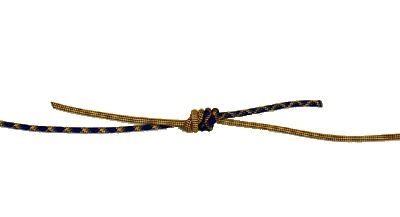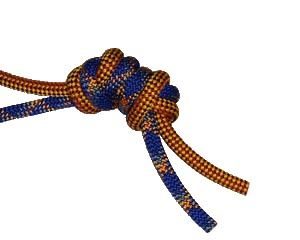Abseil Knots
These notes are intended to assist the climber who has already gained some knowledge of rock climbing and is fully aware of its risks but still wishes to progress further up the grades, and indeed the mountains. They are brief and not designed to be comprehensive in any way.
Ultimately climbing is a dangerous sport and claims many casualties each year. One of the guiding principals of British climbing and mountaineering is that it is the individual climber is responsible for his or her own safety. If you cannot accept this then this site and probably climbing in general is unlikely to suit you. May we refer you to this very interesting site instead!
Abseils - doncha hate 'em'? You're cold/wet/tired/frightened/distracted, or more likely all five together. The weather has turned gnarly/you've run out of daylight/you've bitten off more than you can chew, on your biggest alpine/winter/sea-cliff route of the year and now its time to bale out. and fast. Probably the most dangerous moment of the day. For whilst if you take a whipper climbing there is a fair chance the rope will save you, fall off abbing and you're stuffed. And even if you don't come to grief due to the anchors giving way, there is always the risk of getting the rope jammed and then having to somehow climb back up to retrieve it. In the storm. In the dark. Doesn't bear thinking about really.
This short article is about one small part of the abseil system, the knot used to join two ropes together, an essential part of any abseiler's repertoire of knowledge and one with more possible versions than most.
In the late '70s, the main knot employed for abseiling was the Double Fisherman's, a knot that is still often so used and is also much in evidence stringing Hexes and other nuts onto cord. It is its major point of suitability for this latter purpose which really makes it unsuitable for the former - that is that it is dashed hard to undo once you have put a bit of a load on it. Multiple abs down an alpine face using one of these jobbies and you'll need the finger strength of Dave Birkett to separate the ropes at the bottom. Double that if the ropes are icy - which they no doubt will be.

Double Fisherman's Knot
Another problem with the Double Fisherman's is that it is symmetrical (ie it sticks out on all sides), thus ensuring that when the ropes are pulled through there is a fair chance of something catching on a nubbin of rock somewhere.
Several versions of abseil knot were tried in the years that followed. You could use a Double Figure of Eight, but whilst this was easier to undo than the Double Fisherman's, it was just as likely to get stuck when pulling the ropes.
Double Figure of Eight Knot
The same applied to the frankly weird Two Figure of Eights joined by a Screwgate Krab Knot. Doubtless there were many other variants.
Double Figure of Eight joined by a Screwgate Krab Knot
Around 1990 years ago the Figure of Eight Knot method appeared. The reaction of many was no doubt similar to the first time they were invited to use a couple of Friends for a hanging belay - "You've got to be joking...!" - but in a short while it became the abseil knot of choice. Here was a knot that was always easy to undo, however many times you abbed on it. Also it was a doddle to tie, unlike most of the alternatives. Moreover it was asymmetrical, and when the ropes were pulled, the bulk of the knot flipped upright so that only a flat surface was dragged across the rock, with far less likelihood of a snarl up.
Figure of Eight Knot
It was even rumoured that paddled Poles, raddled Ruskies, and other crazy Continentals dispensed with the Figure of Eight bit, and just used a simple Overhand Knot (all the advantages of the Figure of Eight and even easier to tie), but that was really dicing with death.. surely. wasn't it? And then one began to hear rumours that the Overhand was actually safer than the Figure of Eight as the latter could disconcertingly unroll along the rope when put under tension - it was time for a rethink.
Overhand Knot
Some of us still weren't happy with just using an Overhand Knot, it seemed far too likely that it also could all too easily unroll or simply get knocked undone, so we devised what could be termed the Double Overhand Knot. This is simply an Overhand Knot (tied leaving a very long tail - at least half a metre) with a second Overhand Knot tied very snugly up immediately behind the first, still leaving a fairly long tail (at least quarter of a metre).
Double Overhand Knot
Intuitively this had to be safer, but it was interesting to put the various knots to the test at Lyon Equipment's headquarters at Dent. Lyon's test rig maestro, Dan Middleton actually ran several tests, using different diameter ropes and wet ropes as well, but as the others did not produce significantly different results from the climber's point of view, we have simply reproduced the most telling results below (all the ropes used were brand new 9mm).
|
Knot Type |
Result |
Slippage on each rope (relaxed) to nearest ‘cm’ |
| Frozen |
Fig 8 |
Flipped at 300 Newtons |
11 |
|
Overhand |
Didn’t flip up to 1000 Newtons |
7 |
|
Double Overhand |
Didn’t flip up to 1000 Newtons |
5 |
| Dry |
Fig 8 |
Didn’t flip up to 1000 Newtons |
5 |
|
Overhand |
Didn’t flip up to 1000 Newtons |
4 |
|
Double Overhand |
Didn’t flip up to 1000 Newtons |
3 |
The first thing to note is that when the ropes were soaked and then frozen there was considerably more slippage than when they were dry. Second, and most importantly, in frozen ropes the Figure-of-Eight Knot flipped over itself at 300 Newtons or 30kg. As the weight of a male abseiler plus kit is likely to be around 80kg this is serious cause for concern. The test of course stopped after the first flip, but in a real situation the weight would be reapplied and the knot would be likely to flip again and again until it rolled off the end of the rope. This didn't happen to the same knot when the ropes were dry, but it looked as if it was likely to, and we were dealing with a perfectly tied knot - more of which later.
This should not actually come as any great surprise to climbers, as, when you look, there is plenty of written evidence around that figure of eight knots used in this way are dangerous, but nevertheless, there are likely to still be climbers out there who have missed this and are still using this knot for abseiling, and in fact a recent accident where a climber received serious multiple injuries can apparently be attributed to use of the figure of eight knot for abseiling. In addition there has been at least one fatality accorded to this knot (1). Really what is needed to grab the attention of the climbing public is a front cover photograph of the suspect knot together with skull and crossbones and suitable headline - "INSTANT DEATH KNOT CONDEMNED" or some such. Instead what we get month after month are endless cover shots of muscular young things swarming over impossible overhangs wearing little more than their underwear and a chalk bag. Great to salivate over maybe (the overhangs I mean), but will they save your life?
Anyway, back on planet Earth, whilst both the Figure of Eight and the Overhand slipped considerably under pressure, the Double Overhand did less so. Of course all the dry knots held - eventually, but the tests were made with new ropes and with a good tail. Also all the knots were very well tied. A poorly laid knot can considerably worsen the test results. This has been shown by American climber Tom Moyer who conducted numerous tests on various ab knots and published the results on the rec.climbing newsgroup (2). In these he showed that a well-tied overhand knot would eventually roll over itself at 486kg, but that a badly tied version would do the same at 91kg. This is against his "gold standard" of a Double Fisherman's Knot which broke the rope (at well over 1000kg) in every case, however sloppily it was tied. Bear in mind when considering these figures, that an abseiler abseiling swiftly and jerkily can exert forces of up to 1.6kN, equivalent to 160kg in weight (3). Of course we all know that knots shouldn't be tied sloppily, and that long tails should be left, but as we said before, you're cold/wet/tired/frightened/distracted, the weather has turned gnarly/you've run out of daylight/ you've bitten off more than you can chew etc, or maybe you've just been distracted by the attractive girl/boy sharing a stance with you. Whatever the reason, we all tie our knots less than perfectly on occasions, so it makes sense to use the safest knot available. Well almost. Actually the safest knot by far would seem to be the Double Fisherman's, but this as stated above is hard to undo and easily jams on rock nubbins etc. As a jammed ab rope may require some serious and potentially dangerous antics to free it, this only means the Double Fisherman'sthe safest if it does not jam.
As a result of all these findings we are convinced that what we term the Double Overhand is the best knot (if not the safest) to use when joining two ropes together for abseiling. It is very easy to tie, it is asymmetric and thus less likely to get jammed, it slips less under load, and it seems significantly less likely to flip over or come undone accidentally than the alternatives. Moreover, each time you tie it, to get the two component knots cinched up tight together, you have to think about what you are doing. This in itself is a significant safety factor as it should lead to you laying the knot correctly even if you are tired.
There are, of course, numerous other components to an abseil, the anchors chosen being by far the most important. And anyone who doesn't know how to use a Prussik loop as an autobloc, really needs their head examining, preferably before it hits the deck. And you should of course always tie a very large stopper knot so as you don't ab off the end of the ropes.
And don't use a Figure of Eight Belay device without reading the BMC's warning that it can twist in use and break open screwgate karabiners with fatal consequences (4).

Double Overhand Knot in close-up
But the knot is a vital link in the chain and the Double Overhand Knot, we are convinced, is by far the best choice for joining two ropes together.
Acknowledgements
We are extremely grateful for the assistance received from Lyon Equipment and in particular Dan Middleton, who provided much of the research material used in this article and conducted the tests on their rig.
This article has been translated into Chinese!
References
- A sobering and very sad account of a fatal accident as a result of using a figure of eight knot at https://groups.google.com/group/rec.climbing/msg/63341c525e831203
- Tom Moyer's research results can be found at https://www.xmission.com/~tmoyer/testing/ .
- Industrial Rope Access - Investigation into Items of Personal Protective Equipment prepared by Lyon Equipment for the Health and Safety Executive (Contract Report 364/2001).
- BMC: Abseiling Screwgate Breakage (see last paragraph on page 3) BMC_Care_Maint_updateMar07_web
- Bushwalkers Wilderness Rescue - Research Page has an excellent and lengthy paper on abseil knots.
- Also worth reading, although you will see that I disagree slightly with his findings, is the article on abseiling by Alun Richardson in OTE 125.
- Though not related to the abseil knot itself, Neville Macmillan's paper Karabiner Breakings when Using a Figure-of-Eight is well worth reading and highlights a potentially fatal combination of screwgate karabiner and figure of eight descender.

Dan Middleton knot testing at Lyon Equipment
“Good judgement comes from experience, experience comes from bad judgement.”
- Unknown